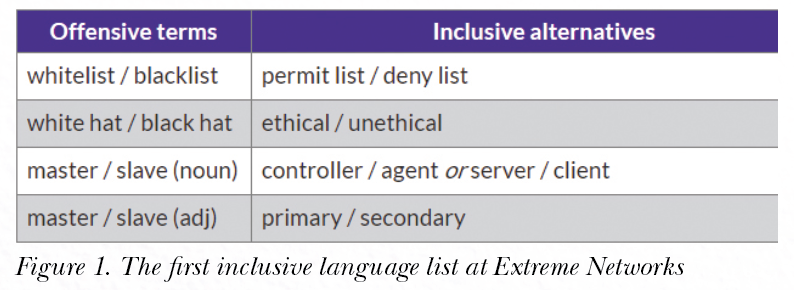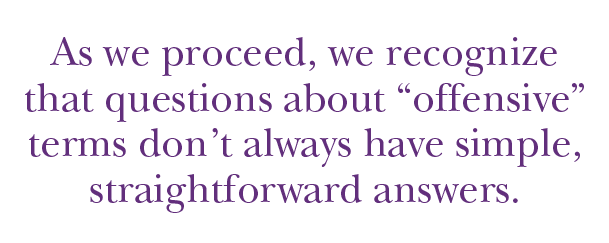By Larry Kunz | STC Fellow
In the world of computer security, those with access to a program are on the whitelist. Everyone else is blacklisted.
How do those terms make you feel? Perhaps you’re accustomed to hearing them, and you take them in stride.
Or perhaps the terms make you feel uncomfortable, even offended. If so, you have plenty of company.
Inclusive language is about using words and phrases that make our readers feel included and comfortable—and avoiding terms that make them feel rejected or offended.
Today’s businesses increasingly understand the value of engaging with their customers. Because inclusive language strengthens the bonds of engagement, it’s good business. And, because inclusive language is grounded in a basic respect for all people, it’s simply the right thing to do.
Inclusive Language at Extreme Networks
In the fall of 2020, the Extreme Networks Information Development team, responsible for all customer-facing technical documentation, launched an inclusive language initiative. We identified a set of problematic terms and inclusive alternatives. Then we surveyed content creators throughout the company, asking them to react to the terms and select the alternatives they preferred.
Our survey revealed a high level of interest: 91 percent of respondents answered yes to the question “Would you like to have a list of inclusive terms, available to all content creators at Extreme?”

After analyzing the survey results and prioritizing the most crucial terms, we added the list of offensive terms and their inclusive alternatives to our style guide. Soon, with the support of Extreme’s corporate-level Diversity and Inclusion Council, we’ll post our list to the corporate intranet, along with a formal company policy, with the message that every content creator in the company is expected to use inclusive language.
Our list will grow as we identify other offensive terms and select the best inclusive alternatives. Our Inclusive Terminology working group serves as the gatekeeper for additions or changes to this list as it includes members of the main content creation groups in the company.
We’re also reaching beyond content creators and engaging with software developers, because command lines, error messages, and user interfaces often contain offensive terms like whitelist and blacklist, or master and slave.
While we can’t expunge offensive terms from long-established software products (or the documentation that describes them), we intend to guarantee—again, with the backing of executives—that new products and features use language that’s inclusive.
 Inclusive Language Across the Content-Creation Community
Inclusive Language Across the Content-Creation Community
I’ve talked about inclusive language with technical writing colleagues from other companies, both one-on-one and in conference settings. People often tell me that they understand the need, but they have no resource to turn to. Few, if any, corporate style guides cover inclusive language, and no one has published a cross-industry list.
My conversation with Julio Vazquez, a technical writer at Cisco Systems, sparked the same eager response at Cisco that it had at Extreme. I’ve also affiliated with the Inclusive Naming Initiative, a cross-industry effort oriented mostly toward software developers, which recently began compiling a list of terms.
Now we’re spreading the word, asking the broader community to help create and validate the public list of terms. This article is part of that effort. We encourage input from all customer-facing content creators including information developers, customer support staff, user experience designers, hardware and software designers and developers, and marketers.
An Ongoing Conversation
As we proceed, we recognize that questions about “offensive” terms don’t always have simple, straightforward answers.
One respondent to our internal survey at Extreme wrote, “Technology has standard terms so that everyone knows what we are talking about. . . This is just people finding offense where there is none.” In fact, you can make a strong case that some words—disable for example—are well established and shouldn’t cause offense to anyone.
Terms like disable inhabit a gray area, and we haven’t decided yet how to handle them. Each term needs to be evaluated separately, and those evaluations are ongoing. In the meantime, we believe that some terms, like the ones in our initial list, are clearly offensive and clearly in need of inclusive alternatives.
Those of us who advocate for inclusive language recognize that reaching our goal will take time and effort. But our original premise reminds us that the time and effort are worthwhile: Inclusive language is good business, and it’s the right thing to do.
How You Can Participate
I invite you to join us in creating a resource that provides guidance to content creators on which non-inclusive terms to avoid, and which terms to use in their place. To participate, send an email to InclusiveTerminology@extremenetworks.com.
If you’re ready to raise awareness for inclusive language in your workplace, I encourage you to discuss these terms with content creators in your organization—because this effort starts with the text itself. It’ll also be helpful to get buy-in from upper management, so that your efforts are accepted company-wide. You can approach your Diversity and Inclusion team (now forming in many organizations) to discuss backing this initiative.
We invite you to start with the word list we expect to publish soon. Contact me to get a current copy and to receive updates as the list evolves.

LARRY KUNZ (lkunz@extremenetworks.com) is a seasoned technical writer, editor, project manager, and trainer, having planned and executed numerous content-development projects for companies as diverse as Extreme Networks, IBM, and Abbott Labs. Larry teaches the Project Management section of Duke University’s Technical Communication certificate program. He holds the rank of STC Fellow and received the STC President’s Award for leading the Society’s strategic planning effort.
REFERENCE
The Inclusive Naming Initiative. n.d. Accessed 7 April 2021. https://inclusivenaming.org.


